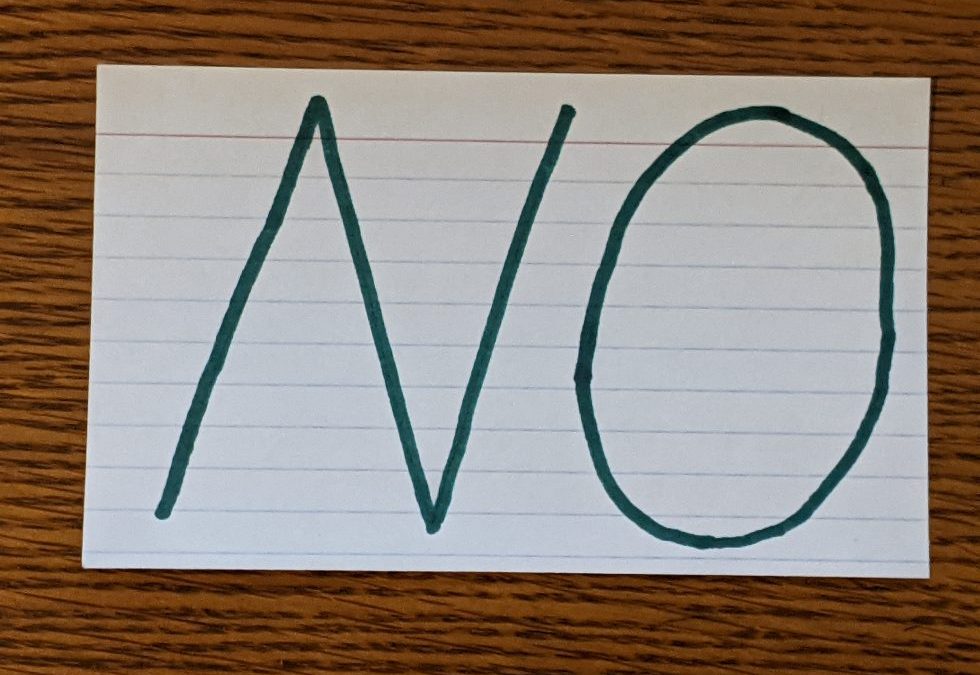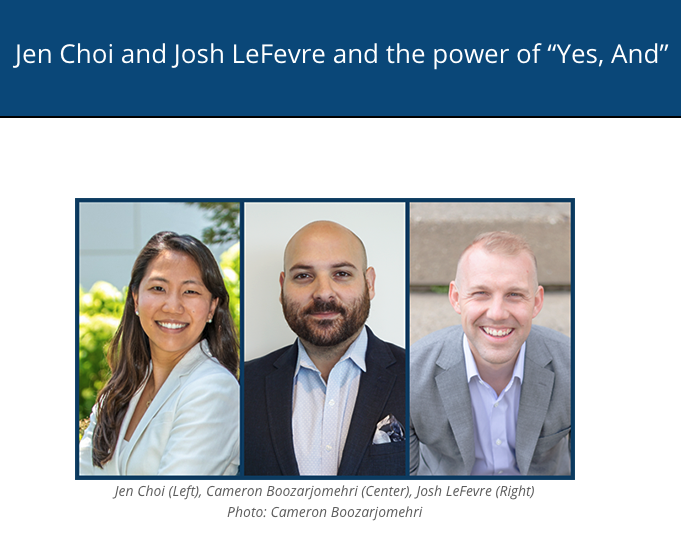
ITK’s Most Frequently Asked Question
As part of our continuing effort to shake things up and experiment with new stuff, this week’s blog post… is a vlog post!

As part of our continuing effort to shake things up and experiment with new stuff, this week’s blog post… is a vlog post!

So your recent session was a bust. You tried to do something but it crashed and burned. Let me be the first to say “Congratulations, and welcome to the club!”
This situation is pretty much inevitable. Stick around in the innovation space long enough, and eventually something going to go pearshaped. And by “long enough,” I mean a day or two. Or less.
See, when the work you’re doing involves introducing novelty that has impact, some of that novelty is pretty much guaranteed to not have the impact you anticipated. It might even impact you right in the face.
For the Innovation Toolkit in particular, every facilitator has led a session or used a tool where the result ended up in the Crummy column instead of the Awesome column. It’s sort of a rite of passage around here. We’ve all had our flops and flubs and disasters, where the participants didn’t participate, the tool didn’t fit, the metaphorical souffle didn’t rise. It happens to the best of us.
Like I said, welcome to the club.
But I also said congratulations, and that’s important. In order to have a failed attempt, you must first make an attempt. So if you failed, that means at the very least you tried something… and that’s worth celebrating. In fact, it probably means you tried something new, which is very celebration-worthy in my book. We need people who are willing to try new stuff – stuff that might not work – and so we celebrate those who take the leap.
Then again, maybe your latest failure is because you got lazy and phoned it in. Maybe your failure was entirely your own fault. That may sound like a dubious thing to celebrate, and it’s frankly my eleventh-least favorite type of failure, but upon closer inspection we may discover something to celebrate there too.
Maybe the reason you didn’t put in the effort is because you’ve put in so much previous effort, you’ve had so much previous success, that you got a little complacent. Resting on your laurels may not be admirable, but it does mean that at some point you earned some laurels. So that’s cool. And let me tell you, those post-success-failures can be a really helpful wake-up call… and that’s why I say congrat’s on noticing the problem and waking up. You are now more aware of what you need to do than you were before. Congratulations.
The other thing to keep in mind is that virtually no failure is completely worthless. You probably created some value, even if it’s not as much value as you’d hoped to create. You probably learned something, even if it wasn’t what you wanted to learn. And there’s a really good chance you helped someone, even if it’s not quite in the way you wanted to help.
At the very least, you survived, so that’s something. Congratulations… and welcome to the club.
(Image credit: Quino Al from Unsplash)

It’s only two letters, but “no” can be a hard word to say.
There are lots of reasons it’s hard to say no, particularly for members of Team Toolkit. We’re an enthusiastic, positive, and curious bunch. We love trying new things and are committed to building a culture of generosity. We love helping people, we sincerely enjoy the work, and we explicitly bring a “Yes, And…” mentality to all our activities. So when a new request comes in, when someone reaches out and asks for our time and attention, our natural inclination is to say yes.
But sometimes, yes is the wrong answer. Sometimes we need to say no. And that’s hard.
Difficult or not, it’s super important to turn down some requests. A discipline of saying no helps us stay focused on the most important, impactful work, and do it in a sustainable way. It prevents us from getting burned out, overcommitted, or spread too thin, from doing work that is not a good fit, or from being distracted from our actual mission. But even though it’s good and important to turn down some opportunities, it’s still not easy to do.
Why is it so challenging? Well, sometimes we feel guilty about saying no, like we’re letting people down by not accepting the invitation. Other times we feel scared, because we’re not sure how the other person will respond or how the decision might impact our career. Saying no can feel like a contradiction to our fundamentally positive character. And of course there’s also FOMO – the fear of missing out, particularly when the thing we’re saying no to sounds like it would be a positive opportunity. It’s tough to say no when a big part of you wants to say yes.
Here are a few techniques that help me in this area:
Do it quickly. Don’t leave the other person hanging for too long – that’s not nice to them, and the longer we delay, the more pressure we feel to say yes. Plus, delaying a decision just eats up the time we’re trying to protect by saying no in the first place.
Set boundaries in advance. Create a little rubric to help filter incoming requests. Just as a plumber should turn down a customer’s request to do electrical work, we decline invitations that don’t require our tools and specialties. For example, if someone asks us to simply run a meeting, we say no. That’s not the kind of facilitation we do.
Don’t offer an explanation. “No” is a complete sentence, and it is perfectly legitimate to say, “Sorry, I can’t do that.” Other variations might include “I’m not available” or “That’s not a good fit.” Resist the urge to give a detailed explanation of why you can’t do it, why it’s not a good fit, or what higher-priority activities you’re already committed to. You’re making a decision, not starting a debate.
Do offer an alternative. Depending on the nature of the request we’re declining, we may be able to suggest a different option. Something like “I’m not available tomorrow but I’m free next Thursday.” Or “I’m not available but maybe Rachel is.” Of course, you can still say no even if you don’t have an alternative, but it helps both parties if you can offer a Plan B.
Don’t negotiate with yourself. Avoid saying stuff like “I can’t do it tomorrow unless you really need it ok maybe I can, just hold on while I rearrange my calendar…” Before you turn your no into a yes, give the other person a chance to accept the first answer. And if they do come back and ask again, you can still hold on to your first “no.” You knew what you were doing when you said it the first time.
One final observation: Saying no takes practice. Just like all hard things, we get better at it the more we do it. So you’re invited start with just one “no” this week and see what happens. We’d love to hear how it goes!

In the world of innovation where moving fast is essential, knowing how to effectively build consensus becomes a superpower.
– – –
Oftentimes, the most powerful outcome of an ITK session is the team building consensus together. Teams are often in a place of confusion or feeling stuck in their problem-solving process when they turn to Team Toolkit for help. Although project leaders and teammates may not have known consensus is what they needed, once they achieve this, there’s a tangible forward shift that occurs in project momentum: When a team is in agreement with each other, the team naturally switches into action because next steps are clear, and the team is motivated to move forward.
So what does building consensus look like? How might we do this effectively?
In a classic scenario of building consensus, teams may gather with blank ITK tools, then answer the question prompts and discuss together. By using blank tools, everyone begins at the same starting point and can generate their own individual responses. The main facilitator creates space for all teammates to speak up equally, and through sharing ideas and perspectives, consensus is built. While this is an effective strategy to build consensus, it may not always be the fastest route to convergence.
When your team needs to build consensus quickly, we recommend leveraging the Power of Prep. The Power of Prep occurs when one or more teammates pre-fill an ITK tool with responses that are intended for discussion. Depending on the team’s situation, these pre-filled answers could be intended to draw out the quieter voices, to confirm unspoken agreements, to explicitly acknowledge controversial areas, or more. By giving the team something to start with, this helps focus and accelerate the discussions.
Keep in mind that the ultimate purpose of pre-filling the ITK tools is to spur discussion, so always use your good judgment and discretion when putting down responses. For example, you don’t want to betray a teammate’s confidence in what they shared privately with you or widely reveal information that’s meant to be close-hold or restricted. Or, if you are the senior person in the group or are in a position of authority, make sure your inputs don’t discourage your teammates from speaking up.
Before you begin, here are some additional Power of Prep Tips:
When you choose to use the Power of Prep, you must be unattached to the pre-filled responses. If not, then you may feel personally criticized when your teammates share their disagreements with the responses. This will cause you go to into a defensive mode, which blocks you from actively listening to others and being receptive to new ideas. Not exactly the most conducive behaviors to building consensus!
In addition, clearly stating that what you’ve written is for discussion rather than your individual perspective allows your teammates more freedom to speak critically about the pre-filled responses. If your teammates were afraid of disagreeing or critiquing your individual perspective, they may hold back their true thoughts which would keep the team stuck and ultimately negatively impact the final product.
So the next time you’re looking to quickly build consensus, consider leveraging the Power of Prep and let us know how it goes in the comments below!

Innovation, much like improv, isn’t easy, but it can be a powerful way to bring people into a conversation they might typically avoid or feel excluded from. In MITRE KDE’s latest podcast episode with the Innovation Toolkit Team, Jen and Josh walk listeners through the power improvisation can have to start these conversations and how they refined their unique approach. Discover the lessons Jen and Josh learned and how you, too, can apply them to your organization!
– – –
Over the summer, Team Toolkit ran an experiment to test whether using “Yes, And” could help cultivate curiosity and innovation, and we were amazed by the results. We knew this was a powerful workshop practice, but we had no idea how effective it would be in the everyday work meetings, especially in our current virtual work environment!
Curious to hear more? Check out the MITRE Knowledge-Driven Enterprise (KDE) podcast episode “Jen Choi and Josh LeFevre and the power of “Yes, And”
The MITRE KDE Podcast series is hosted by Software Systems Engineer Cameron Boozarjomehri, who interviews technical leaders at MITRE that have made knowledge sharing and collaboration an integral part of their practice.

One of the key elements to birth innovation is creativity, which is usually associated with the arts rather than science and engineering. However, creativity is not confined to only one domain, and there are ample ways to cultivate curiosity on even the most left-brained teams.
One powerful technique is borrowed from the world of Improv, where the best improv performers build their scenes using a technique called “Yes, And”. Yes-And is a cornerstone practice in all sorts of improvisational creation, whether it is comedy or jazz or painting happy little trees. The basic idea is to affirm a previous contribution (yes), then build or expand on it (and). Team Toolkit hypothesized that teaching Yes-And could help cultivate creativity and innovation. We decided to test our hypothesis with a group very familiar to us at MITRE – Our fellow engineers!
Team Toolkit invited a half-dozen colleagues to join us for a series of four online workshops where we practiced Yes-and, and also explored how to apply this practice to our everyday technical work. They said yes… and so we dove right in!
Our workshops introduced the concept and practice of Yes-And, as well as the benefits, perils, and lessons from this approach. We practiced improv exercises, stretched people outside of their comfort zone, and had a lot of fun! In between the laughs, we also learned about what it takes to truly practice Yes-and. Active listening is crucial to hear what our colleagues are saying, so we can respond to it. We also learned that the more vulnerable we are with each other, the easier it becomes to share our ideas.
We discussed how these concepts apply to our work as engineers. Sometimes our “expert culture” can prevent us from actively listening to our colleagues in meetings. By practicing Yes-And, we force ourselves to not only listen, but to build on each others’ ideas to create better solutions.
The results of our experiments confirmed our hypothesis that Yes-And can be taught, and that it can also help improve the quality and impact of our work.
However, what surprised us the most was the personal impact that our experiment had on our participants. Here are some of the things they had to say:
Who knew that one Improv practice could transform people’s views, actions, and outlooks!
So, if you’re looking to cultivate innovation in your organization, definitely try practicing Yes-and and encourage your teammates to learn this skill. Let us know in the comments below how your experience goes!